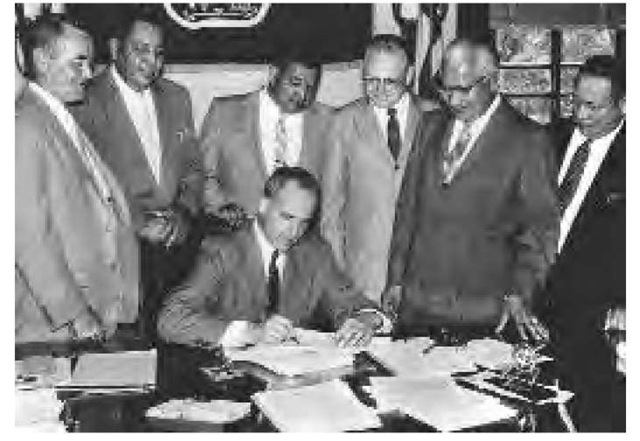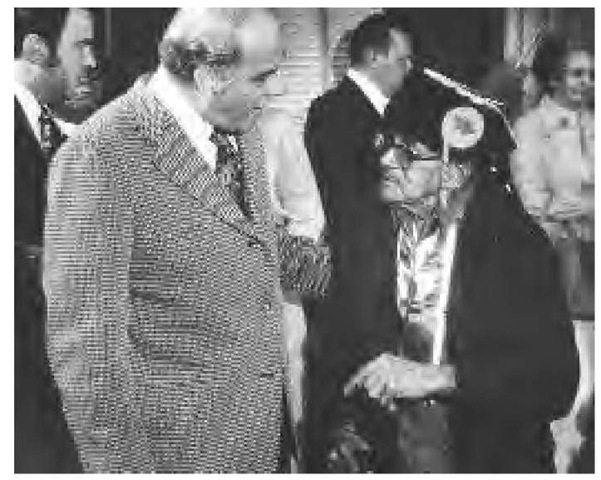Menominee![]() , from Manomini, Anishinabe for "Wild Rice People." The Menominee were culturally related to the Winnebago and Anishinabe.
, from Manomini, Anishinabe for "Wild Rice People." The Menominee were culturally related to the Winnebago and Anishinabe.
Location The Menominee controlled nearly 10 million acres along the northwestern shore of Lake Michigan and west into central Wisconsin. Today, most live on a reservation on the Wolf River in northern Wisconsin.
Population From a population of perhaps 3,000 in the early seventeenth century, the Menominee have grown to around 7,000 people in the early 1990s.
Language Menominees speak an Algonquian language.
Historical Information
History Shortly after the first non-natives made contact with the Menominee people in the mid-seventeenth century, Iroquois warriors drove the Menominees into the Green Bay area, possibly from Michilimackinac. Jesuit missionaries arrived among them in 1671. The people maintained generally friendly relations with non-natives, especially the French, with whom they occasionally intermarried.
Participation in the fur trade from the late seventeenth century through the early nineteenth century broke the tribe into small, mobile bands of hunters-trappers. They avoided many of the colonial and other wars of the eighteenth and nineteenth centuries, although some sided with the British in the American Revolution and the War of 1812. With the fur-bearing animals depleted, and under pressure from non-natives, the Menominee in 1854 ceded all of their remaining lands except for a reservation on the Wolf River in north-central Wisconsin.
On the reservation, a split soon developed between pagans and Christians, traditionalists and progressives. Some people tried farming in the later nineteenth century, but as this was generally unsuccessful, many soon turned to lumbering. In the early twentieth century, with the help of the U.S. Forest Service, the Menominee began harvesting their prime timber resources for sustained yield. Their sawmill became the center of economic activity and the tribe’s most important employer.
Despite the government’s mismanagement of the tribe’s timber resources (for which the tribe won a legal judgment and collected an award of over $7.5 million in 1951), the Menominee were among the country’s most economically stable and prosperous tribes by the early 1950s. Suddenly, they learned that they were to experience the effects of a new government policy. The tribe was officially terminated, or removed from its special relationship with the federal government, in 1961. The reservation became a county and the tribe a corporation.
The Menominee are perhaps the classic termination disaster. Termination-related expenses soon depleted their cash reserves. When the hospital was forced to close, the people experienced a sharp rise in tuberculosis and other health problems. The low tax base could not finance needed government services, and the tribe, once self-sufficient, sank into poverty. Faced with total financial collapse, it was forced in the late 1960s to sell off prime waterfront real estate to non-natives. Many people began to judge the intent of termination by its effects: the destruction of a relatively prosperous Indian group and the further transfer of its prime land to non-natives.
Governor Nelson of Wisconsin is shown signing a bill that created Menominee County, July 31, 1959. After the Menominee signed this agreement, their community fell upon hard times.
In reaction to these developments and to the related possibility that non-natives would make up a majority of the county’s voters, a new organization, the Determination of Rights and Unity for Menominee Shareholders (DRUMS), called for a new federal trust relationship for the tribe as well as tribal self-determination. Although termination was reversed in 1973, and most of the former reservation was restored, the tribe has yet to recover from the devastating effects of the termination.
Religion Mecawetok, who may have been identified with the sun, was the Great Spirit and supreme creative force. There were many levels of deities and spirits, some friendly and some evil; the latter were assumed to reside below the earth. Most people sought to obtain spiritual power with the help of a guardian spirit, which one acquired in a vision through fasting and dreaming. Dreams were in some ways the entire basis of living: They determined an individual’s sacred songs, dances, and ceremonies. One’s power was said to increase with age.
Medicine bundles contained various personal sacred charms. There may have been several old religious cults made up of medicine men or people with outstanding power. People with particularly strong powers included witches and "jugglers." The latter were curers and diviners.
The Midewiwin (medicine lodge) Society was a secret society of shamans. Membership was by invitation or inheritance; initiation was highly ritualized. Each member possessed a medicine bag as well as strong and benevolent medicines.
The Dream Dance or Drum Dance contained some precontact elements. Membership was relatively unrestricted. Members petitioned the sacred spirits with drums and related rituals to obtain supernatural power. The ceremonies were highly ritualized, and codes of behavior were associated with what essentially was a religion.
Ernest Neconish, elder statesman of the Menominee Indians of Wisconsin, chats with Senator Gaylord Nelson of Wisconsin during a Washington, D.C., ceremony, April 22, 1975, in which the tribal land of the Menominee Indians was restored to reservation status.
Government Clan chiefs were probably hereditary. Chiefs of the Bear Clan served as tribal chiefs, and the various lineage chiefs made up the village council. Nonhereditary chiefs achieved status through their dreams or war exploits. These people might be war leaders, lead public celebrations, or enjoy other duties and responsibilities.
A band system replaced clans and villages during the late seventeenth century and early eighteenth century. Bands tended to follow clan lines but were mostly based on friendships. The hereditary system of leadership became less important, replaced by skills such as excellence in trapping and an ability to negotiate with non-natives. There was also a tribal council from this time on.
Customs The Menominee were divided into two divisions, Bear and Thunderbird. Each was in turn divided into patrilineal clans. Smoking tobacco accompanied nearly every important activity. Certain relatives were allowed or encouraged to joke with each other as a means of maintaining social mores and order.
The male sphere included ceremonies, tool and weapon manufacture, and war. Women saw to the home and children; grew, collected, and prepared all food; were responsible for firewood, water, and carrying goods; and made clothing and items associated with food and the home. Women could also participate in many male activities, such as fishing, hunting, dancing, and some power ceremonies.
Boys and girls undertook ten-day dream fasts at puberty; these were the culmination of short childhood fasts. There was also a feast following a boy’s first game kill. Children were toughened by icy plunges and other such means. Women were isolated during their menstrual periods and after childbirth because they were thought to threaten the balance of spiritual power.
Marriages were generally arranged by elders, who took their lead from a couple to a greater or lesser degree. They were probably formalized by an exchange of gifts. Men might have more than one wife. Corpses were placed on scaffolds, but in the later historical period they were painted red and placed in birch-bark coffins, along with personal items. Mourners blackened their faces with charcoal, but funerals were accompanied by feasting and sport.
Dwellings Winter houses were domed wigwams, with cattail and reed mats placed over bent saplings. These structures were especially used after contact with non-natives in winter hunting camps. Rectangular summer houses were made of bark over a pole framework. Other hut-type buildings were used for sweat lodges, for women’s seclusion, and for ceremonial purposes. Permanent villages usually contained a lacrosse field.
Diet Wild rice—which is not rice but a grass seed—gave this tribe its name and was a staple, along with fish. It was collected in summer by people, usually women, in canoes. The method entailed bending the plants over and knocking them with paddles; the seeds fell into the bottom of the canoes. They were then dried, pounded, and winnowed, with the grain boiled and served in a stew or with maple syrup.
Men hunted large game, such as deer and buffalo. They also hunted small game from canoes. They relied more on hunting once they became involved in the fur trade. Bundles or charms helped ensure cooperation from spirits. Men also fished for sturgeon and other fish in Green Bay and in nearby streams. They fished through the ice in winter. Women grew small gardens of corn, beans, squash, and tobacco. They also gathered berries and maple sap.
Key Technology Fish were caught using traps, hooks, spears, and woven bark-fiber gill nets. Women wove pouches of plant fibers and buffalo hair. These items served many purposes, such as food storage and protection of ceremonial items. They also wove and dyed cattail, rush, or cedar-bark mats and winnowing trays, and they made pottery. Hunting equipment and weapons of war included the bow and arrow, clubs, and knives made of a variety of materials such as bone, stone, and copper. The people also used stone axes.
Trade Wild rice was a major export, as were items made of stone and wood. The people imported buffalo hides and other prairie items, catlinite (pipestone), and copper.
Notable Arts Menominee women made especially fine pottery, pouches, and clothing decorated with porcupine quills and animal hair. Motifs included geometric figures and sacred beings.
Transportation Men made bark and dugout canoes as well as snowshoes.
Dress Men wore deerskin breechclouts, shirts, leggings, and moccasins. Women wore woven nettle shirts as well as deerskin robes, leggings, and moccasins. Both decorated their clothing with paint and porcupine quills. Both also wore copper jewelry and rubbed oil and grease on their hair and bodies.
War and Weapons The Menominee were not known for their aggressiveness. Nevertheless, they were often at war. They were generally friendly with the Winnebago and occasionally enemies with the Sauk and Fox. Weapons were similar to hunting tools.
Contemporary Information
Government/Reservations The Menominee Reservation, Menominee and Shawano Counties, Wisconsin (established in 1848) consists of roughly 230,000 acres of land. The 1990 Indian population was nearly 3,200. A 1977 constitution and by-laws call for an elected nine-member legislature as well as a tribal chair, a judiciary, and a general council.
Economy Gaming operations are central to the new tribal economy; profits underwrite a host of social and health services.
Legal Status The Menominee Indian Tribe of Wisconsin is a federally recognized tribal entity.
Daily Life Most tribal members are Christians, although the Big Drum religion is also popular, as are the Ojibwa-based Warrior’s Dance, the Native American Church, and Medicine Lodge ceremonies. A renewed clan structure exists among the people. The language is in use and taught in school. The College of the Menominee Nation is located in Keshena. The people host an annual powwow. Substance abuse remains a daunting challenge. The tribe is committed to maintaining its sovereignty and its Indian identity.


